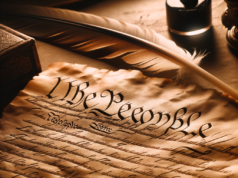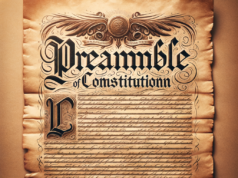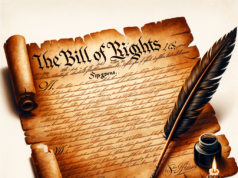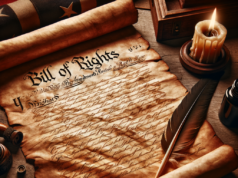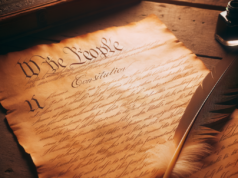
Charting the Course of Freedom: The Writing of the United States Constitution
Introduction:
The creation of the United States Constitution stands as a pivotal moment in American history, when visionary leaders gathered to establish the framework for a new nation. The story of the Constitution’s writing unfolds against the backdrop of post-revolutionary America, where challenges and aspirations converged to shape the destiny of a young republic. In this article, we delve into the historical context and timeline of the momentous events that unfolded when the Constitution was written.
A Call for Change:
Following the American Revolution, the Articles of Confederation served as a governing document for the newly formed United States. However, the weaknesses of this system quickly became apparent. In the summer of 1787, recognizing the pressing need for a more cohesive national government, delegates from twelve states (Rhode Island abstained) convened in Philadelphia for what would become the Constitutional Convention.
The Constitutional Convention:
On May 25, 1787, the doors of the Pennsylvania State House swung open, marking the beginning of an intense and transformative journey towards a new constitution. The fifty-five delegates, representing a cross-section of American society, gathered under the guidance of George Washington, who was elected president of the convention.
Debates and Deliberations:
Over the course of four months, these remarkable men engaged in vigorous debates. They sought to strike a delicate balance between the power of the federal government and the rights of individual states. Intellectual giants such as James Madison, Benjamin Franklin, and Alexander Hamilton contributed their ideas, shaping the structure of the government, the separation of powers, and the protection of individual liberties.
Compromises and Consensus:
The Constitutional Convention was marked by numerous compromises, essential for uniting a diverse group of delegates with conflicting interests. The Great Compromise, also known as the Connecticut Compromise, resolved the dispute between large and small states regarding representation in Congress, establishing a bicameral legislature with proportional representation in the House of Representatives and equal representation in the Senate.
Protecting Rights and Liberties:
A fundamental concern for the framers was the safeguarding of individual rights and liberties. The addition of the Bill of Rights, comprising the first ten amendments to the Constitution, met this demand. Inspired by the Virginia Declaration of Rights and similar state constitutions, the Bill of Rights explicitly outlined protections against government intrusion and guaranteeing basic freedoms such as speech, religion, and due process.
Signing and Ratification:
On September 17, 1787, after countless debates, revisions, and compromises, the final draft of the Constitution was signed by thirty-nine delegates. However, the journey did not end there. The Constitution had to be ratified by at least nine states to become effective. This process triggered fierce debates across the country, ultimately leading to the ratification of the Constitution on June 21, 1788.
Legacy and Enduring Relevance:
The Constitution of the United States has proven to be an enduring document, laying the foundation for one of the world’s oldest functioning democratic republics. Its longevity can be attributed to its flexibility and the ability of subsequent generations to interpret and adapt it to changing times.
Conclusion:
The writing of the United States Constitution remains a testament to the foresight and wisdom of the Founding Fathers. Through intense deliberations and principled compromises, they laid the groundwork for a nation built on democratic principles, checks and balances, and the protection of individual liberties. Today, the Constitution serves as a guiding light, ensuring that the values of freedom, justice, and equality remain central to the American identity.
The Constitution of the United States as a result of a conglomerated effort, both fueled and inspired by the foremost of political thinkers and authors of the time. The framers of the Constitution are considered to be every individual involved in the construction of the document, from its inception to its actual penning.
The Fathers of the Constitution are considered to include not only those members of the Continental Congress responsible for restructuring the perceived flaws of the Articles of Confederation, but also the representatives sent from all of the 13 states, which had a hand in its transformation.
Subsequent to the approval of the content of the Constitution, the document was sent to Independence Hall in Philadelphia in 1787 to receive its final modifications. Pending the approval of the document itself at the Constitutional Convention, the Constitution was distributed to all 13 states of the United States in order to win the approval of at least 9 of those states – the ratification of the Constitution was commensurate on this. Yet, most historians cannot agree on a conclusive Father of the Constitution. Although quite a few of the men present upon the ratification of the Constitution have been credited with the honor of Framer of the Constitution, the following list illustrates the main contenders:
● Alexander Hamilton: A representative from New York, as well as a renowned Federalist, he has been credited with the initial ideology expressed in the Constitution. The practices that were proposed in his Federalist Papers, a direct explication of the perceived flaws of the Articles of Confederation, have been credited with both the inspiration and the framework of the Constitution.
● James Madison: A Federalist credited with the collective authorship of the Federalist Papers. He has been considered by many to be the Father of the Constitution. Due to his acumen in political thought and theory, he applied a majority of the tenets expressed in the Federalist Papers to the ideology of the Constitution and oftentimes has been regarded as providing the groundwork and structure to the document.
● Thomas Jefferson and John Adams: Thomas Jefferson has also been credited as the Father of the Declaration of Independence. He, as well as John Adams, are both considered to be the primary framers of the Constitution. Yet, in an ironic turn of events, they were both in Europe on diplomatic assignment during the ratification of the Constitution, and thus, neither of the two signed the document.
● Roger Sherman: Many historians argue that without Roger Sherman’s introduction of the Connecticut Plan, a selection process for individual State legislation, the ratification of the Constitution might never have taken place. As a result of his ingenuity and ability to meet the collective needs of all 13 states, he is credited as a Father of the Constitution.
Though historians might never agree on who was the single-most prominent Father of the Constitution, there exists at least one facet upon which a majority of historians agree: The framers of the Constitution were amongst the most innovative, revolutionary, and progressive political minds of their time.



